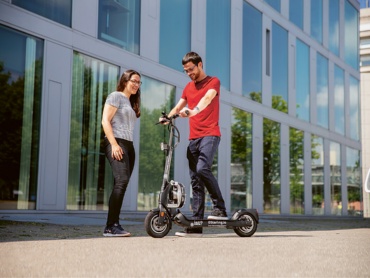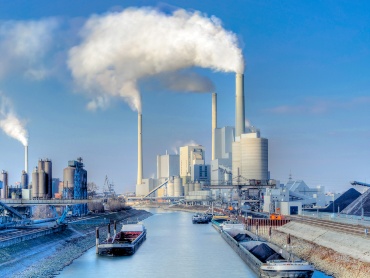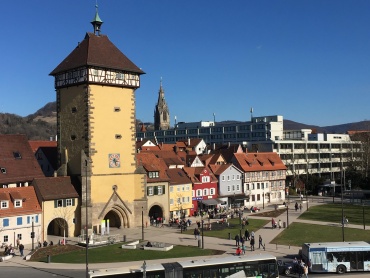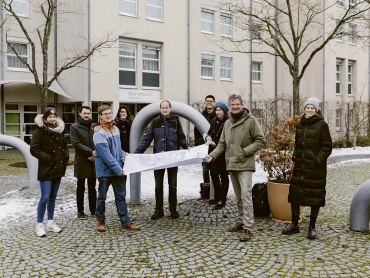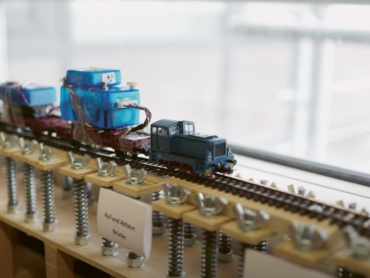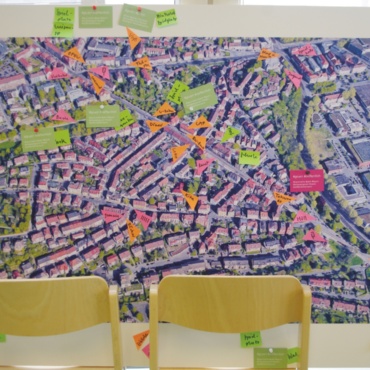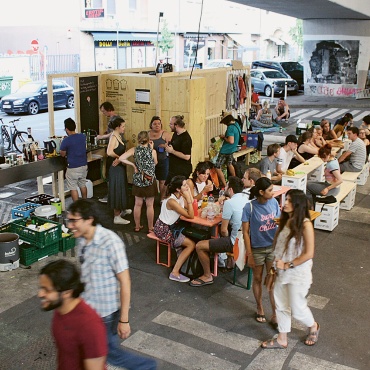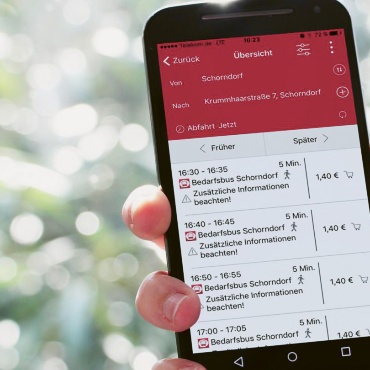
The thing that unites all those involved in the "CampUS hoch i" Real-World Laboratory is the vision of a climate-neutral, sustainable campus. The interdisciplinary team from the fields of engineering, sociology, and sustainability management is breaking new ground to achieve this goal. Under the auspices of the University of Stuttgart’s Institute for Energy Economics and the Rational Use of Energy (IER), the aim is to develop specific proposals for how the university buildings on the Vaihingen Campus could be renovated and redesigned in a climate-neutral, intelligent, and cost-effective manner – and to do so in collaboration with the people who study, teach, conduct research, and work there.
According to IER Director, Prof. Kai Hufendiek: "Fifty percent of energy use in this country is for heating buildings and hot water generation, and buildings currently account for almost half of the emissions throughout Germany." At 75 percent of the greenhouse gas emissions, he adds, the figure is even higher at the Vaihingen Campus. There are many ways to incorporate more sustainability and energy efficiency within the construction sector, he continues; these range from the use of waste heat and the installation of solar systems and heat pumps, to smart building management systems and innovative construction materials. "We can already do this well in new buildings.” However, as the energy systems expert predicts, “although existing buildings present a considerable challenge, they also have great potential."
Involving all stakeholders in the design process
One way to make existing buildings more energy-efficient is to incorporate novel technologies, but this can only be done sustainably if users are involved in the design process from the outset. "The Real-World Laboratory has been guided by this idea right from the start," says Hufendiek's project partner, the sociologist Prof. Cordula Kropp, Director of the University of Stuttgart's Center for Interdisciplinary Risk and Innovation Studies (ZIRIUS). "Our starting point is the perspective of the various stakeholders, and we specifically ask them what they need so that we can meet their space requirements whilst minimizing the buildings' CO2 emissions," she explains.
This approach typifies the Real-World Laboratory concept. Real-World Laboratories promote transdisciplinary and transformative research, i.e., they leave the academic cosmos behind to meet people in the reality of their everyday lives in order to experiment together and address the urgent issues of the future. The state of Baden-Württemberg is vigorously pushing this concept under the motto "Science for Sustainability" and is one of the pioneers of Real-World Laboratory research in Germany, having set up 14 Real-World Labs between 2015 and 2020. Science Minister Theresia Bauer sees the "made in BW" Real-World Labs as a model of success.
Railcar Real-World Laboratory
In the railcar Real-World Laboratory, Professor Ullrich Martin and his team are aiming to detect damage to busy and heavily frequented railway tracks at an early stage. A railcar and track model has been built for this purpose at the University of Stuttgart's Institute of Railway and Transportation Engineering (IEV). This project is being conducted in close cooperation with the Institute of Engineering Geodesy (IIGS).
The University of Stuttgart was an early adopter of Real-World Labs
With two Real-World Laboratories that addressed the processes of change and transformation in the city, the University of Stuttgart has been involved right from the outset. For example, the Future City Lab_University of Stuttgart - Real-World Laboratory for Sustainable Mobility examined various facets of mobility development in urban areas, whilst the City:Quarters 4.0 Real-World Laboratory was focused on innovative digital tools for urban planning. The “CampUS hoch i" Real-World Laboratory is currently focused on combating climate change in the construction sector.
The yellow brick building that houses the University of Stuttgart's Institute of Construction Materials (IWB) is a good example of how the various stakeholders interact in this context. Built in 1959, it is now due for a comprehensive refurbishment, particularly with regard to fire safety and prevention and power supply. The actual conditions of use will be taken into account during the planning and implementation phases in order to ensure the success of the construction measures, which is why the ZIRIUS not only asked students and staff at the IWB about their expectations of the building, but also worked out how to align these expectations with the needs of the administration and planning authorities.
From ecological concrete to smart sensors
The project partners are studying various perspectives on what will be possible in buildings of the future. Among other things, for example, IWB Director Prof. Harald Garrecht and the two PhD students Christien Hein and Lisa Hoss are working on ecological concrete types, which are designed to provide load-bearing capacity, insulation, and a pleasant indoor climate in lightweight buildings using as little material as possible. For instance, a modular "room cell" is being planned in the course of the lab, the purpose of which is to enable people to actually experience the effect of the new building materials.
Just how important intelligent technologies are for achieving a climate-neutral energy supply can also be seen at the Institute for Building Energetics, Thermotechnology and Energy Storage (IGTE), where, scientist Sven Stark introduces visitors to the world of sensor systems that, for example, can detect whether doors and windows are open or closed, analyze the indoor climate, and even record how many people are in a particular room and where, which makes for optimal control of the energy demand and supply.
We're combining technology and user worlds, which ultimately changes both.
Professor Cordula Kropp
"What we can do with sensor technologyis virtually unlimited ," says Stark. But how do people cope with it? Do they feel overwhelmed or as if they are being monitored? Such questions will be addressed through focus group analyses that include ideas and past contributions from campus members regarding ecological transformation. "We're combining technology and user worlds, which ultimately changes both," says Kropp.
Stimulating lasting change
Prof. Martina Baum, head of the University of Stuttgart's Institute of Urban Planning and Design, has also set herself the goal of creating experimental spaces in real contexts to stimulate lasting change and is already very experienced in Real-World Laboratory research, for example, as a member of the aforementioned Lab for Sustainable Mobility Culture.
Researchers there have joined forces with other Stuttgart-based associations and institutions, the City Council and the public, and together they have been exploring ideas and concepts that could help return space to people in a car-oriented city, or even open up new spaces. Some large-scale practical experiments and many smaller projects have been conducted there, some of them with a tremendous amount of commitment from the students. Some of these "temporary interventions" are now being continued by the general public or are being incorporated into urban development plans. "It was clear that the sensitization we initiated through this lab actually had an impact," says a positive Baum.
As the expert observes, the success of a Real-World Lab will always depend on the specific conditions and the people involved. The key thing, according to him, is communication, but also the synchronization of the scientific, social and, administrative processes and, last but not least, accepting failure. Consequently, the University of Stuttgart has already accumulated a considerable amount of expertise in the planning and implementation of Real-World Laboratories.
Researchers at the International Center for Cultural and Technological Studies (IZKT) are now planning to use and keep this knowledge alive in the course of an initiative known as the "Knowledge transfer reloaded. The Stuttgart Real-World Laboratory research project". Not only will the resulting “lab literature” be analyzed, but also the lessons learned from the workshops. The current focus is on launching a website where knowledge, for example about good practices for real experiments, can be collated and presented in a way that is specific to the relevant target group. "We want to highlight the successes, but also the challenges," says Natalia Pfau, a scientific coordinator at the IZKT. One important element will be a "method case" in which the various approaches used by the individual disciplines will be brought together. "Because,” as Pfau explains, “it always has to do with craftsmanship, too.”
No solutions for the ivory tower
But what happens after the project and presentations are over and the reports have been written? "That’s when you need anchor points in the community – groups of people and institutions that will commit to the cause over the long term," says urban planner Baum. As energy systems expert Kai Hufendiek emphasizes, the aim of "CampUS hoch i" is not to develop solutions for the ivory tower, but rather for broad, long-term application: "Rather than building high-end model buildings, we want to create something that is realistic and affordable.
And community participation is absolutely necessary, which is why Cordula Kropp and her team, as well as Birgit Mack, Karolin Tampe-Mai, and Michael Ruddat, have set up a very special real experiment. A permanent site hut on the Vaihingen Campus will in future enable visitors to experience what sustainable and climate-neutral construction means in practice. "We are actually continuing the age-old cultural tradition of cathedral building lodges," Kropp explains. Craftsmen in the Middle Ages were able to study and test innovative technologies and new materials in these site huts (or lodges as they were known then). And like the Real-World Laboratories, they created novel insights from real-world experience that could be put to use directly in the field.
Editor: Jutta Witte
Real-World Laboratories at the University of Stuttgart
[Photos: University of Stuttgart, Grosskraftwerk Mannheim AG, City of Reutlingen, University of Stuttgart, University of Stuttgart]
Completed Labs
[Photos: University of Stuttgart, University of Stuttgart, DLR]







